


The article titled "10 Key Insights on RCTs Study for Clinical Research Success" elucidates the essential factors that underpin the success of randomized controlled trials (RCTs) in the realm of clinical research. RCTs are acknowledged as the gold standard, a status earned through their rigorous methodologies, which include randomization and control groups. These elements not only bolster the reliability of results but also minimize biases, thereby exerting a significant influence on clinical practice and shaping treatment guidelines.
The landscape of clinical research is rapidly evolving, with randomized controlled trials (RCTs) leading this transformation. As the gold standard for establishing causality, RCTs not only shape medical guidelines but also significantly influence treatment protocols across various healthcare sectors. However, the increasing complexity and cost associated with these trials raise critical questions about their accessibility and applicability in real-world settings.
How can researchers effectively balance the rigor of RCTs with the necessity for diverse, representative patient populations to ensure that findings translate into clinical practice? This article delves into ten key insights on RCTs, exploring their methodologies, ethical considerations, and the impact of innovative platforms like bioaccess® in accelerating clinical research success.
bioaccess® harnesses its extensive expertise across Latin America, the Balkans, and Australia to significantly enhance the research environment for rcts study and observational studies. By capitalizing on the region's regulatory efficiency—achieving ethical approvals in just 4 to 6 weeks—and utilizing diverse patient populations, bioaccess® ensures that trials are both efficient and compliant. This strategic approach leads to patient enrollment rates that are 50% faster than those in traditional markets, thereby substantially reducing the time to market for Medtech, Biopharma, and Radiopharma innovators.
The advantages of conducting an rcts study in these regions are profound, with startups in Colombia realizing over 30% cost savings compared to their counterparts in North America and Western Europe. Additionally, the expedited IRB/EC and MoH review process, averaging 90-120 days, further enhances operational efficiency.
Recent advancements in clinical trials within Latin America underscore the region's growing significance, as it now represents 10% of the global research sites, thereby bolstering the reliability and applicability of research findings. As regulatory frameworks continue to evolve, the necessity for swift approvals and effective patient recruitment becomes increasingly paramount for companies striving to deliver innovative therapies to patients in need.
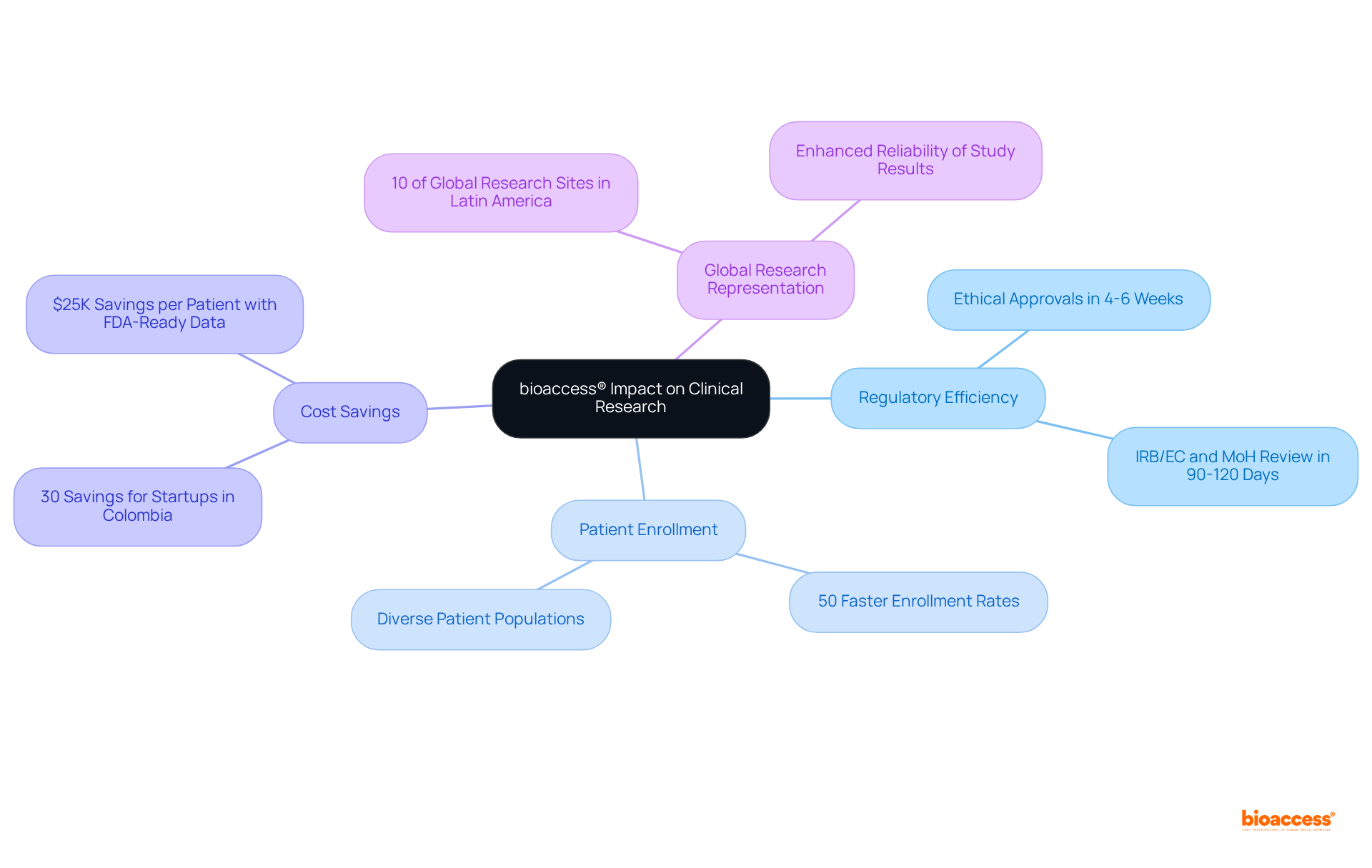
The rcts study is meticulously structured to evaluate the efficacy of interventions by randomly assigning participants to either treatment or control groups. This randomization minimizes bias, enabling researchers to draw causal inferences with high internal validity. In contrast, descriptive research, which does not utilize randomization, examines outcomes in naturally occurring groups, offering valuable insights into real-world effectiveness.
Recent evaluations suggest that the rcts study comprises approximately 70.7% of experimental investigations, underscoring their dominance in medical research. However, research analyses prevail in the landscape, accounting for 75.1% of health science investigations, with cross-sectional designs being the most prevalent at 75.3%. This trend reflects the growing recognition of the importance of real-world data in understanding treatment impacts outside controlled environments.
Insights from research directors highlight that while the rcts study is crucial for determining efficacy, non-randomized assessments can be more practical and ethically justifiable in specific situations, particularly when randomization is not feasible. The selection among these designs ultimately depends on the research question, available resources, and the particular context of the investigation, with RCTs providing strong evidence of intervention effects and non-experimental studies capturing the complexities of real-world applications.
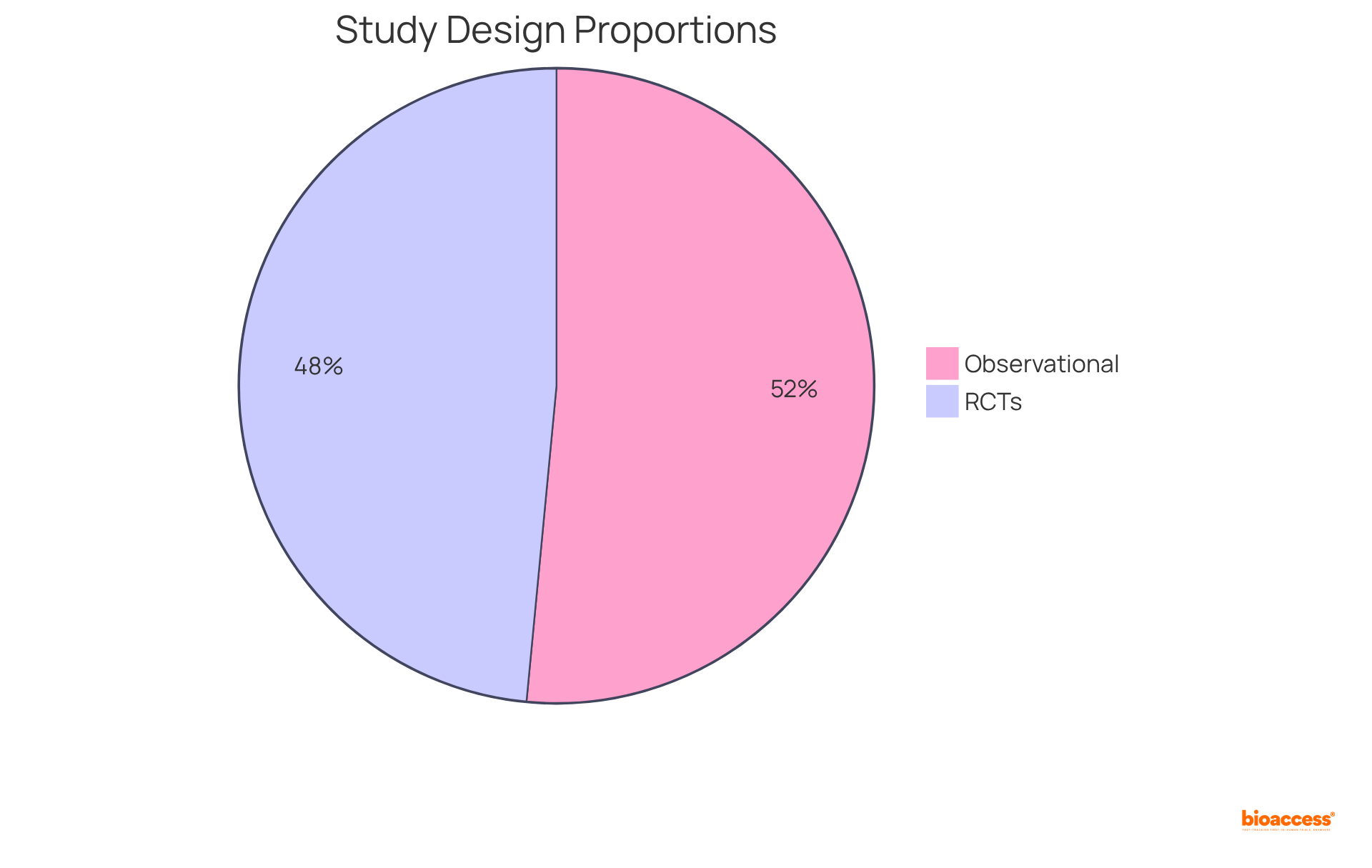
The RCTs study is widely recognized as the gold standard in clinical research, primarily due to its rigorous methodologies, which encompass randomization, blinding, and control groups. These features significantly bolster the reliability of results by minimizing biases and confounding variables. In contrast, while empirical research is useful, it often lacks the same degree of control, potentially leading to less conclusive outcomes. Nevertheless, well-structured research can provide essential insights, particularly in scenarios where RCTs may be impractical or unethical. For instance, observational research has proven crucial in identifying the long-term effects of treatments across large populations, yielding results that can inform clinical practice.
Statistical evaluations reveal that only 17% of research reported by newspapers consists of randomized controlled trials, compared to 35% in prestigious journals, highlighting a significant tendency towards non-experimental research in media reporting. In fact, 75% of research covered by newspapers is descriptive, contrasting with 47% for journals. This trend emphasizes the necessity of acknowledging both methodologies' strengths and limitations. Clinical researchers assert that while the RCTs study is vital for establishing causality, non-experimental analyses can enhance RCTs by providing context and practical applicability. As the landscape of medical research evolves, advancements in data collection methods continue to improve their robustness, making them a valuable asset in the research toolkit. As noted by a prominent clinical researcher, "The development of research frameworks that observe is essential for comprehending intricate health results in real-world environments.

Bias is a crucial factor in both randomized controlled experiments and non-experimental research, yet the sources and effects of these biases differ markedly. The RCTs study is designed to minimize selection bias through randomization, ensuring that treatment groups are comparable. In contrast, observational research encounters inherent challenges, such as confounding and selection bias, necessitating meticulous design and statistical adjustments to mitigate these issues. For instance, statistical techniques like propensity score matching can help control for confounding variables, thereby enhancing the validity of the findings.
Comprehending these biases is essential for precisely interpreting research findings. A meta-research analysis revealed that 33% of articles raised concerns about unclear reporting or high risks of selection bias, while 31% discussed biases in the limitations section. This underscores the importance of transparency in research methodologies. Furthermore, only 25% of articles proposed solutions to mitigate these biases, with only five articles describing a solution to address selection and immortal time biases. This highlights a significant gap in addressing methodological challenges.
Experts emphasize the necessity for strict criteria in reporting and methodology to enhance the dependability of empirical research. As one specialist remarked, 'The necessity of the RCTs study for establishing the highest level of evidence remains a topic of substantial disagreement,' indicating ongoing debates within the research community regarding the best methods for research design. Additionally, the significance of open data standards and cooperation among research teams is essential for improving the quality of observational research. By acknowledging and addressing these biases, researchers can draw more reliable conclusions that ultimately enhance clinical decision-making and patient care. To enhance clarity and reduce bias, researchers are urged to embrace particular reporting guidelines in their investigations.

Randomization serves as the cornerstone of randomized controlled experiments, ensuring that participants are assigned to treatment groups purely by chance. This approach significantly mitigates biases linked to participant characteristics in the RCTs study, facilitating the formation of comparable groups. By effectively balancing both known and unknown confounding factors, randomization bolsters the internal validity of the trial. Consequently, researchers can draw more reliable conclusions regarding the efficacy of the tested intervention based on the RCTs study.
For example, a recent study by Zampieri et al. involving 10,520 critically ill patients underscored the pivotal role of randomization in preserving the integrity of results, ultimately leading to more precise evaluations of treatment effects. Furthermore, experts emphasize that well-designed RCTs study, particularly those utilizing block and stratified randomization, can circumvent selection bias and ensure that trial groups genuinely mirror the intended demographic.
It is also crucial to acknowledge the potential limitations of RCTs, including the disparity between therapeutic efficacy and effectiveness arising from stringent selection criteria. Additionally, implementing emergency unblinding protocols is vital for upholding trial integrity during serious adverse events. This methodological rigor is essential for establishing the credibility of medical evidence and supports robust statistical analyses, which are indispensable for valid inferences in medical research.
To enhance the effectiveness of randomization in your clinical trials, consider these methodologies and protocols during your planning and execution.
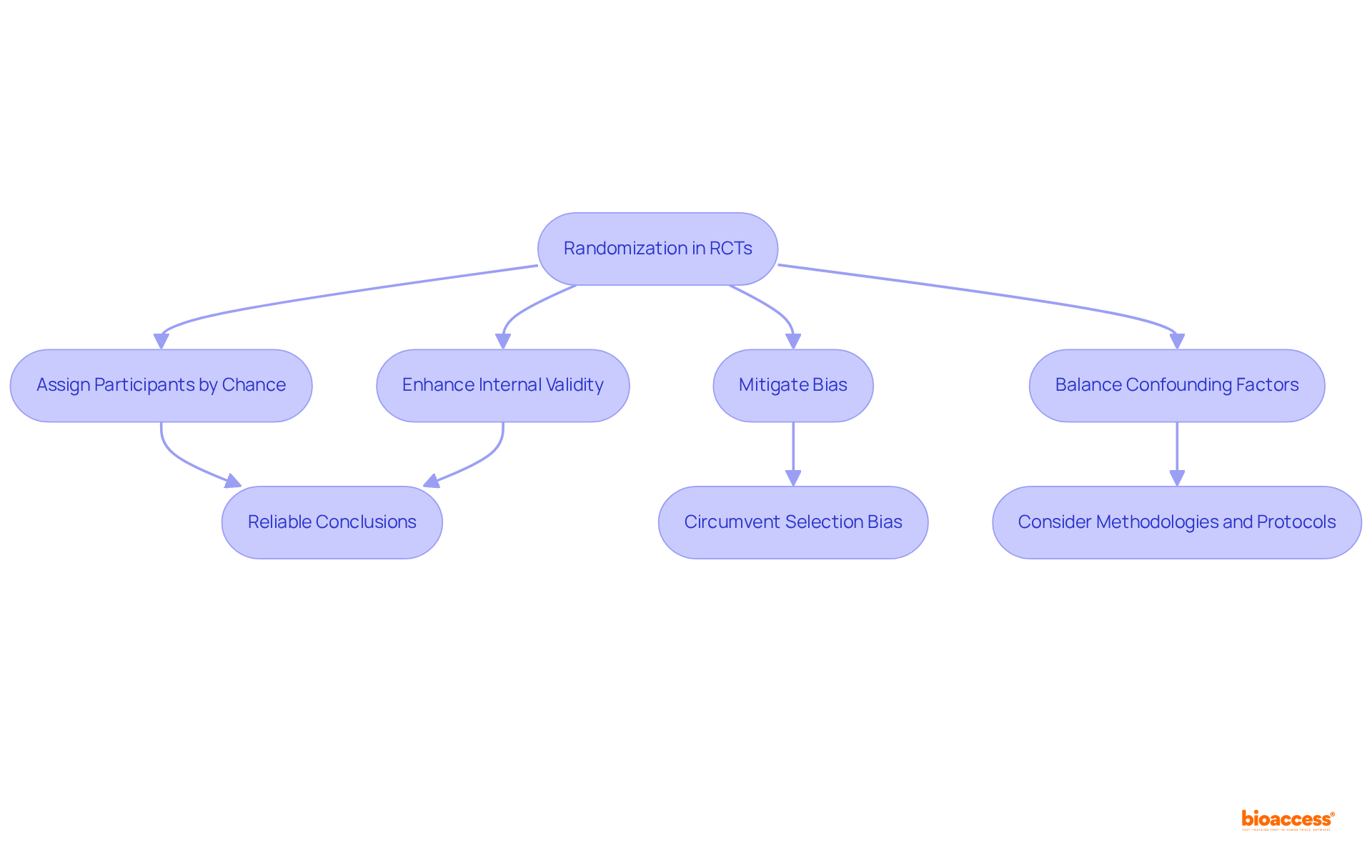
Randomized controlled studies often face scrutiny regarding their generalizability, primarily due to strict inclusion criteria and regulated environments. While these trials excel in internal validity, establishing trustworthy cause-effect relationships, their results may not always resonate with broader populations. An RCT study conducted by Abby Statler and colleagues examined 98 phase II and III RCTs in hematologic malignancies, revealing that:
This narrow patient demographic raises significant concerns about the applicability of RCT results to real-world clinical practice, particularly given the restrictive eligibility criteria that may limit patient inclusion.
Conversely, observational research typically encompasses more diverse populations and reflects real-world environments, thereby enhancing external validity. However, these studies often lack the rigorous controls inherent in randomized clinical trials, which can introduce confounding factors that complicate result interpretation. Recent discussions among medical researchers, including insights from Statler, underscore the necessity of balancing internal and external validity. As she pointed out, "We have this push and pull between internal and external validity - between the trial's ability to demonstrate a cause-effect relationship and the actual generalizability of those results."
Excessively stringent eligibility standards in RCT studies may hinder the inclusion of patients who could benefit from new therapies. Expanding these criteria could enhance the relevance of trial outcomes to everyday clinical scenarios, ultimately bridging the gap between controlled research and practical application. To improve the generalizability of RCT findings, it is imperative to consider the implications of exclusion criteria and the potential advantages of including a broader patient demographic.
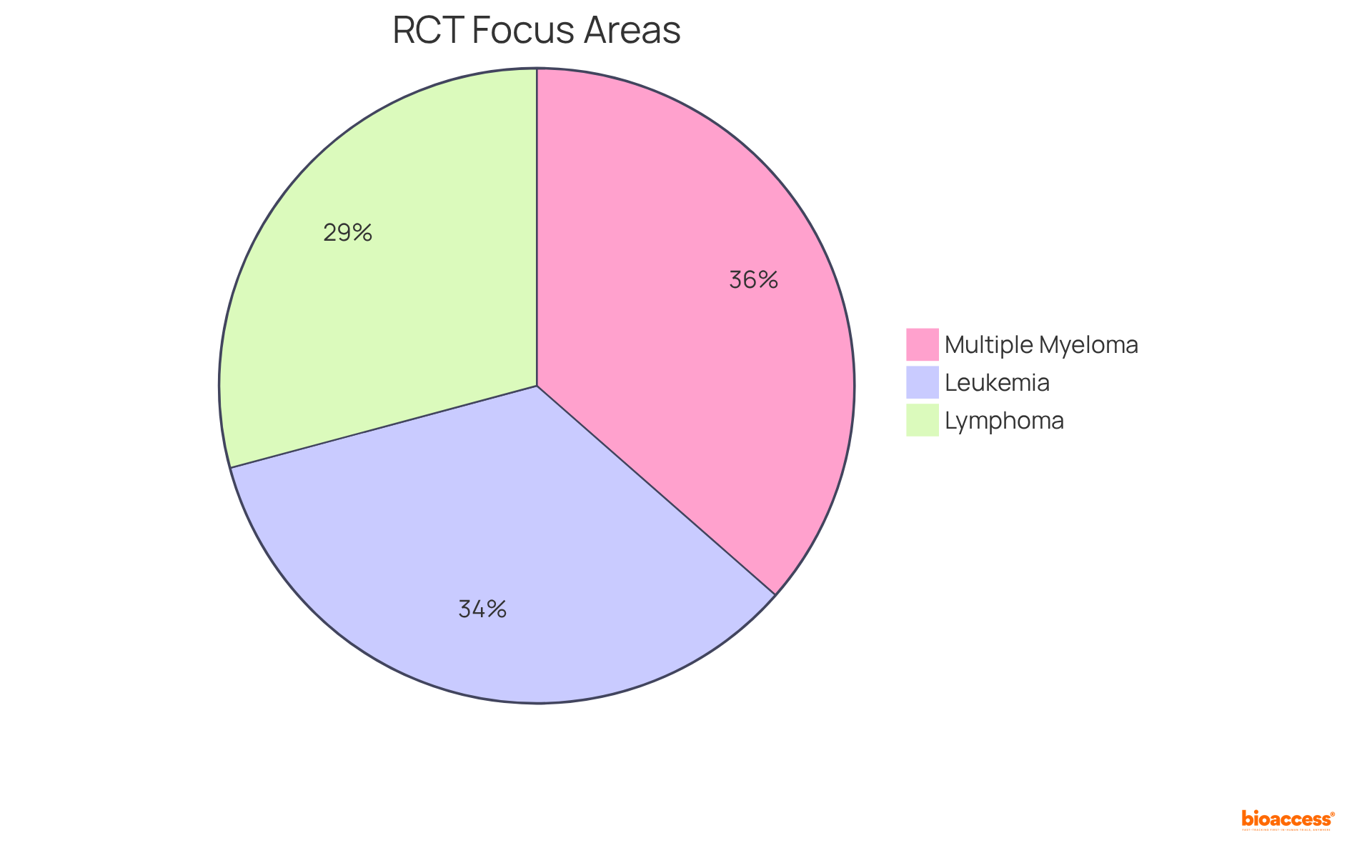
Both randomized controlled experiments and observational research must adhere to stringent ethical guidelines, although the factors involved can differ significantly. The RCTs study necessitates informed consent, randomization, and often the implementation of placebo controls, which can lead to complex ethical dilemmas. The requirement for informed consent in the RCTs study is paramount, ensuring that participants fully understand the nature of the research and its potential risks. Recent statistics reveal that informed consent rates in clinical trials can fluctuate, with some reports indicating compliance rates as high as 90%, while others expose notable gaps in participant comprehension.
Conversely, observational research, while generally less invasive, still requires robust ethical oversight to safeguard participant privacy and ensure informed consent. Ethical supervision in these studies is essential for maintaining participant trust and integrity throughout the research process. For instance, ethical committees frequently review observational studies to confirm that participant data is managed confidentially and that consent is appropriately obtained.
Researchers must adeptly navigate these ethical landscapes, balancing the necessity for scientific rigor with the imperative to protect participant rights and welfare. As bioethicists emphasize, the ethical dimensions of medical research extend beyond mere procedure; they are fundamental to the credibility and success of the research itself. This careful navigation is crucial for fostering trust and ensuring the integrity of research outcomes.
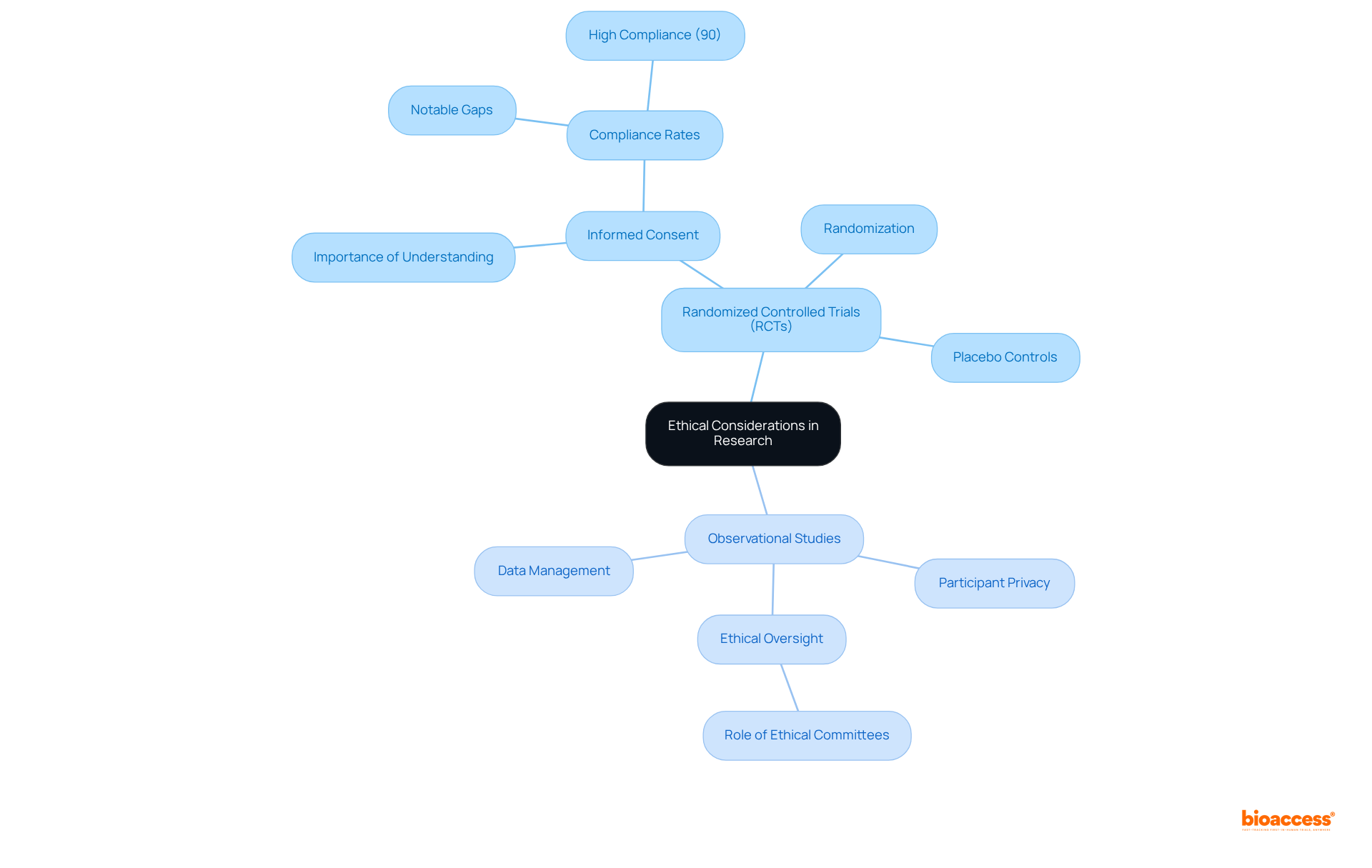
Comprehending the regulatory framework governing the rcts study is paramount for the success of clinical research. The rcts study is subject to more stringent regulations than non-experimental research, necessitating adherence to rigorous protocols established by regulatory bodies. This includes:
In contrast, observational research, while still regulated, often enjoys greater flexibility in its design and execution. Successful observational studies have demonstrated the ability to adapt to evolving regulatory environments, underscoring their significance in medical research.
Recent modifications in trial regulations in 2025 have further underscored the necessity of compliance. Statistics reveal that nearly 30% of MAUDE reports are filed late, with 10% submitted more than six months past due. Such compliance rates can significantly influence the success of clinical research initiatives. Therefore, it is crucial for researchers to grasp these frameworks to ensure compliance and facilitate successful project approvals.
To enhance your research approach, consider establishing a robust compliance monitoring system and staying informed about regulatory changes to effectively navigate the complexities highlighted in the rcts study of randomized clinical trials.
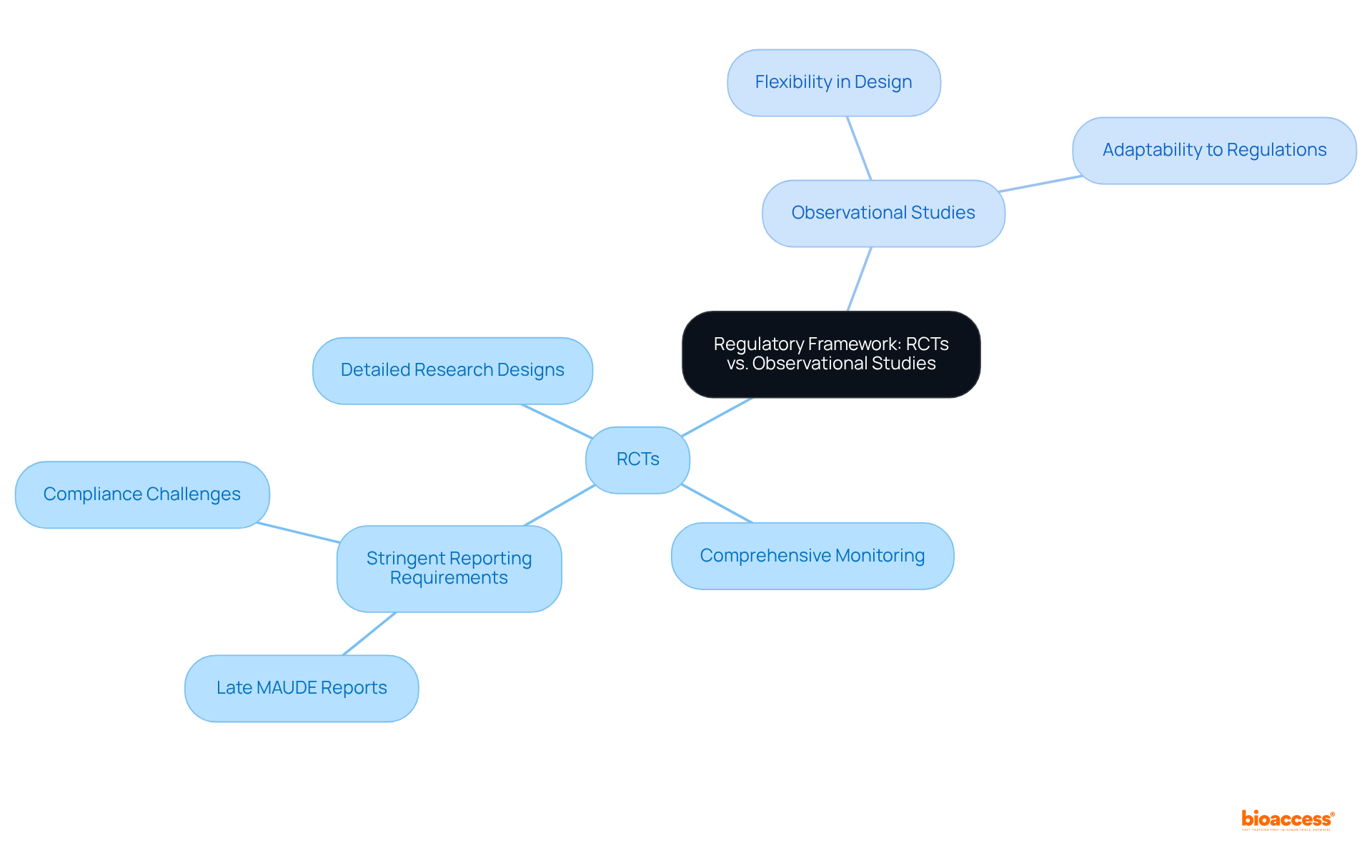
Conducting RCTs study typically incurs greater expenses than observational studies, primarily due to their inherent complexity, the necessity for randomization, and stringent regulatory criteria. Key costs associated with the RCTs study encompass:
For instance, the MI FREEE trial revealed an average duration of 49 days from hospital discharge to randomization, underscoring the substantial time and resource commitments required. Recent research indicates that the average expense of RCTs study has escalated significantly, reflecting the increasing demands for rigorous methodologies and regulatory compliance. Conversely, while observational research may appear less costly, it can still lead to considerable expenses related to data management and analysis. Understanding these financial implications is crucial for researchers and sponsors as they plan and budget for their studies, ensuring that resources are allocated effectively to achieve successful outcomes. With over 15 years of experience in medical research, bioaccess® emphasizes the importance of strategic budgeting and resource management in navigating these complexities.

Randomized Controlled Trials (RCTs) are widely recognized as the gold standard in medical research, primarily due to their rigorous design that establishes causality, making the RCT study an essential component of evidence-based medicine. The findings from these trials often lead to significant modifications in treatment protocols and medical guidelines, thereby shaping the landscape of healthcare practice. Recent analyses reveal that approximately one-third of RCT results can diverge from previous meta-analyses, emphasizing the necessity for ongoing reassessment of treatment strategies informed by the latest evidence. Furthermore, documented error rates ranging from 10% to 40% in evaluations comparing meta-analyses with RCTs underscore the critical importance of integrating diverse data sources into clinical decision-making.
Conversely, empirical assessments, while less definitive, are vital for understanding real-world effectiveness. They provide insights into patient outcomes that RCTs may overlook, particularly within heterogeneous populations. For example, research analyses have influenced treatment guidelines by identifying care deficiencies and highlighting areas for improvement, thereby illustrating their value in medical decision-making.
Current trends suggest an increasing incorporation of real-world data (RWD) into healthcare practices, as evidenced by the FDA's draft guidance advocating for the integration of RCT findings with RWD in the RCT study to enhance the relevance and applicability of research outcomes. This shift reflects a broader recognition of the importance of observational research in shaping treatment protocols, as it adds context and depth to the findings of the RCT study. However, challenges such as obtaining informed consent in traditional clinical trials, especially when merging RCTs into clinical practice, must be addressed to uphold ethical standards.
Healthcare leaders emphasize the significance of both research methodologies in advancing medical knowledge. Experts assert that the interplay between RCTs and observational studies is crucial for formulating comprehensive treatment guidelines that are both evidence-based and representative of real-world patient experiences. This collaborative approach ultimately seeks to enhance patient care and outcomes across various medical disciplines.
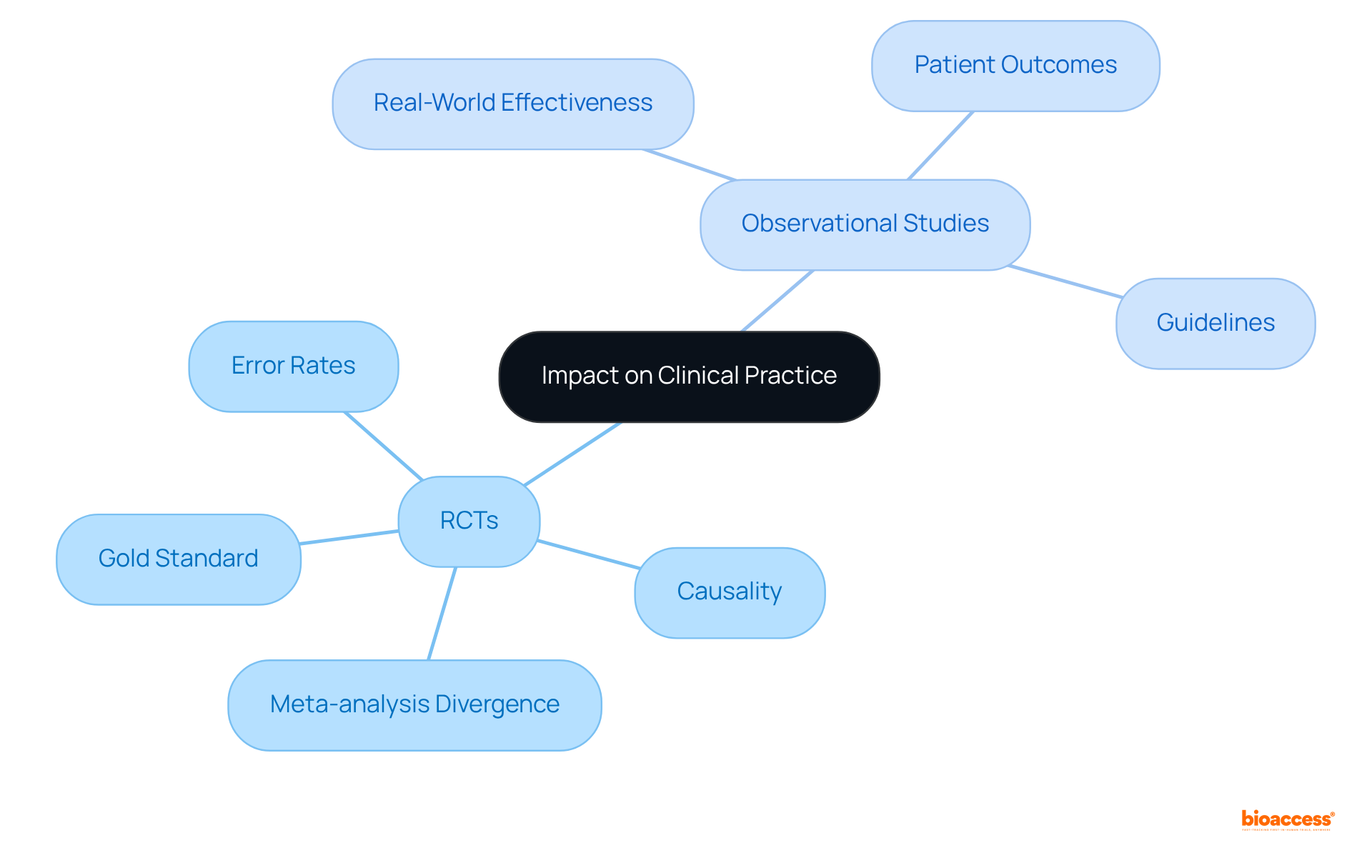
The exploration of randomized controlled trials (RCTs) and observational studies reveals their distinct yet complementary roles in clinical research. RCTs stand out as the gold standard due to their rigorous methodologies, which minimize bias and enhance the reliability of findings. Conversely, observational studies provide valuable insights into real-world effectiveness, highlighting the importance of context in understanding treatment impacts. Both approaches are essential for advancing medical knowledge and improving patient care.
Key insights underscore the advantages of conducting RCTs in regions with efficient regulatory frameworks, such as Latin America, where ethical approvals and patient enrollment can occur at an accelerated pace. The significance of methodological rigor, bias considerations, and the ethical complexities inherent in both study designs cannot be overstated. Moreover, a balance between internal validity, as exemplified by RCTs, and the external validity offered by observational studies is crucial. This ultimately advocates for a collaborative approach to enhance clinical practice.
In conclusion, understanding the nuances of RCTs and observational studies is crucial for researchers and healthcare professionals alike. As the landscape of clinical research continues to evolve, embracing both methodologies fosters a more comprehensive approach to evidence-based medicine. By leveraging the strengths of each, researchers can better address the complexities of health outcomes and improve the quality of care delivered to patients. The call to action is clear: prioritize collaboration and integration of diverse data sources to drive innovation and enhance patient outcomes in clinical practice.
What is bioaccess® and how does it enhance clinical research for RCTs and observational studies?
bioaccess® is an organization that leverages its expertise across Latin America, the Balkans, and Australia to improve the research environment for RCTs and observational studies. It achieves ethical approvals in 4 to 6 weeks and utilizes diverse patient populations, leading to patient enrollment rates that are 50% faster than traditional markets, thus reducing time to market for Medtech, Biopharma, and Radiopharma innovators.
What are the cost benefits of conducting RCTs in regions served by bioaccess®?
Startups in Colombia, for example, can realize over 30% cost savings compared to their counterparts in North America and Western Europe when conducting RCTs in these regions.
How does the regulatory process in these regions contribute to research efficiency?
The expedited IRB/EC and MoH review process averages 90-120 days, enhancing operational efficiency for clinical trials.
What is the significance of Latin America in the global clinical research landscape?
Latin America now represents 10% of global research sites, which enhances the reliability and applicability of research findings as regulatory frameworks continue to evolve.
What are the key differences between RCTs and observational studies?
RCTs are structured to evaluate interventions by randomly assigning participants to treatment or control groups, minimizing bias and allowing for causal inferences. Observational studies examine outcomes in naturally occurring groups without randomization, providing insights into real-world effectiveness.
What percentage of medical research is comprised of RCTs and observational studies?
RCTs account for approximately 70.7% of experimental investigations, while research analyses make up 75.1% of health science investigations, with cross-sectional designs being the most prevalent at 75.3%.
Why are RCTs considered the gold standard in clinical research?
RCTs are recognized as the gold standard due to their rigorous methodologies, including randomization, blinding, and control groups, which minimize biases and confounding variables, leading to reliable results.
How do observational studies contribute to clinical practice?
While RCTs are crucial for establishing causality, observational studies can identify long-term treatment effects across large populations, providing valuable insights that inform clinical practice.
What is the trend in how research is reported in the media versus prestigious journals?
Only 17% of research reported by newspapers consists of RCTs, compared to 35% in prestigious journals, indicating a tendency towards non-experimental research in media reporting, with 75% of newspaper research being descriptive.
How can non-experimental analyses enhance the understanding of clinical research?
Non-experimental analyses can provide context and practical applicability to RCTs, capturing the complexities of real-world applications and improving the overall understanding of health outcomes.